Managed Futures: Portfolio Diversification Opportunities
Enhance returns and lower overall volatility.
Copyright CME Group (Chicago Board of Trade, cmegroup.com)
In a world of increasing volatility, CME Group is where the world comes to manage risk across all major asset classes -interest rates, equity indexes, foreign exchange, energy, agricultural commodities, metals, and alternative investments like weather and real estate. Built on the heritage of CME, CBOT and NYMEX, CME Group is the world's largest and most diverse derivatives exchange encompassing the widest range of benchmark products available. CME Group brings buyers and sellers together on the CME Globex electronic trading platform and on trading floors in Chicago and New York. We provide you with the tools you need to meet your business objectives and achieve your financial goals. And CME Clearing matches and settles all trades and guarantees the creditworthiness of every transaction that takes place in our markets.
Futures trading is not suitable for all investors, and involves the risk of loss. Futures are a leverages investment, and because only a percentage of a contract's value is required to trade, it is possible to lose more than the amount of money deposited for a futures position. Therefore, traders should only use funds that they can afford to lose without affecting their lifestyles. And only a portion of those funds should be devoted to any one trade because they cannot expect to profit on every trade. All orders are entirely at your risk, and it will be your responsibility to monitor these orders. There are limitations to the protection given by stop loss orders therefore we give no assurance that limit or stop loss orders will be executed, even if the limit price is met, in full or at all.

The term managed futures describes an industry comprised of professional money managers known as commodity trading advisors (CTAs). These trading advisors manage client assets on a discretionary basis using global futures markets as an investment medium. Trading advisors take positions based on expected profit potential.
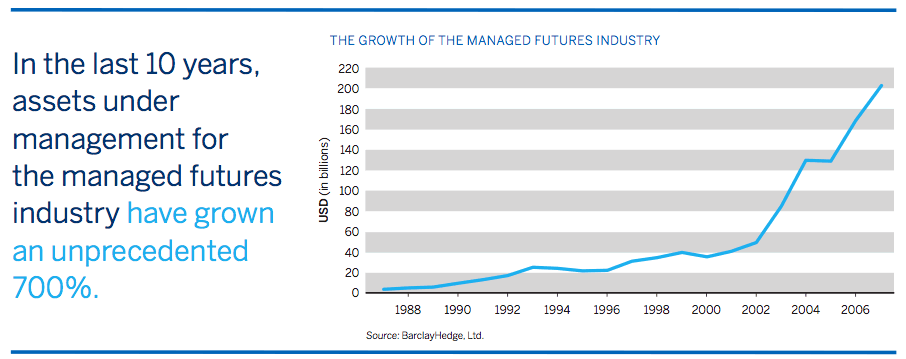
Managed futures have been used successfully by investment management professionals for more than 30 years. Institutional investors looking to maximize portfolio exposure continue to increase their use of managed futures as an integral component of a well- diversified portfolio. With the ability to go both long and short, managed futures are highly flexible financial instruments with the potential to profit from rising and falling markets. Moreover, managed future funds have virtually no correlation to traditional asset classes, enabling them to enhance returns as well as lower overall volatility.
Recent growth in managed futures has been substantial. In 2002, it was estimated that more than $45 billion was undermanagement by managed futures trading advisors. By the end of 2007, that number had grown to more than $200 billion.
BENEFITS OF MANAGED FUTURES
By their very nature, managed futures provide a diversified investment opportunity. Trading advisors can participate in more than 150 global markets; from grains and gold to currencies and stock indices. Many funds further diversify by using several trading advisors with different trading approaches.
In this example, the overall risk is reduced by almost 82 percent from -41.0 percent to -7.5 percent and the return also increases almost 20 percent from +7.4 percent to +8.9 percent. This is mainly due to the lack of correlation and, in some cases, negative correlation between some of the portfolio components in the diversified portfolio. There is even negative correlation between stocks and managed futures as the two markets move independently from each other.
The benefits of managed futures within a well-balanced portfolio include:
1. Potential to lower overall portfolio risk
2. Opportunity to enhance overall portfolio returns
3. Broad diversification opportunities
4. Opportunity to profit in a variety of economic environments
5. Limited losses due to a combination of flexibility and discipline
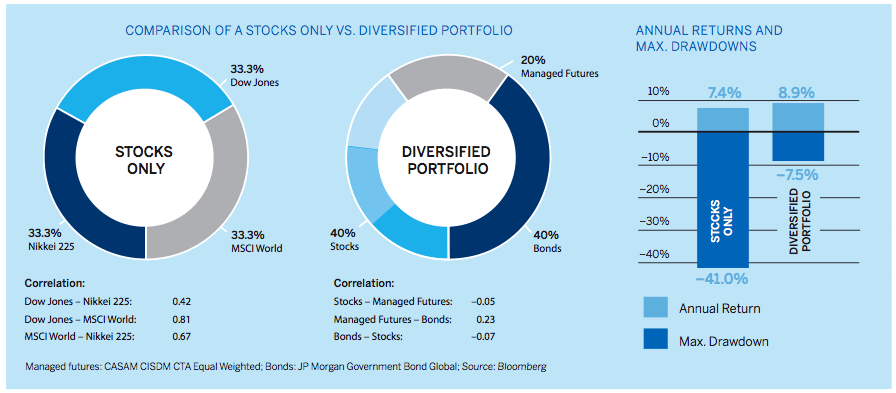
1. POTENTIAL TO LOWER OVERALL PORTFOLIO RISK
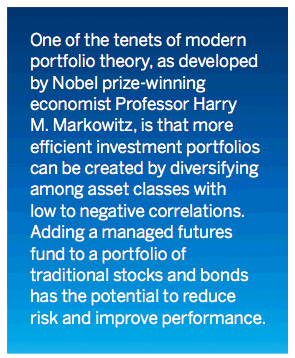 The main benefit of adding managed futures to a balanced portfolio is the potential to decrease portfolio volatility. Risk reduction is possible because managed futures can trade across a wide range of global markets that have virtually no long-term correlation to most traditional asset classes. Moreover, managed futures funds generally perform well during adverse economic or market conditions for stocks and bonds, thereby providing excellent downside protection in most portfolios.
The main benefit of adding managed futures to a balanced portfolio is the potential to decrease portfolio volatility. Risk reduction is possible because managed futures can trade across a wide range of global markets that have virtually no long-term correlation to most traditional asset classes. Moreover, managed futures funds generally perform well during adverse economic or market conditions for stocks and bonds, thereby providing excellent downside protection in most portfolios.

2. OPPORTUNITY TO ENHANCE OVERALL PORTFOLIO RETURNS
While managed futures can decrease portfolio risk, they can also simultaneously enhance overall portfolio performance. The following chart illustrates that adding managed futures to a traditional portfolio improves overall investment quality while also potentially reducing risk.
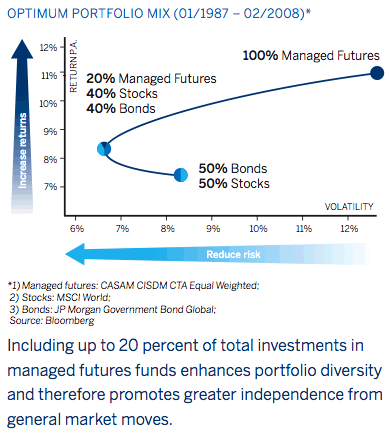 This has been substantiated by an extensive bank of academic research, beginning with the landmark study by Dr. John Lintner of Harvard University in which he wrote: "... the combined portfolios of stocks (or stocks and bonds) after including judicious investments... in leveraged managed futures accounts show substantially less risk at every possible level of expected return than portfolios of stocks (or stocks and bonds) alone.
This has been substantiated by an extensive bank of academic research, beginning with the landmark study by Dr. John Lintner of Harvard University in which he wrote: "... the combined portfolios of stocks (or stocks and bonds) after including judicious investments... in leveraged managed futures accounts show substantially less risk at every possible level of expected return than portfolios of stocks (or stocks and bonds) alone.
3. BROAD DIVERSIFICATION OPPORTUNITIES
MANY DIFFERENT FUTURES MARKETS
Managed futures are highly flexible financial instruments traded on many regulated financial and commodity markets around the world. By broadly diversifying across global markets, managed futures can simultaneously profit from price changes in stock, bond, currency and money markets, as well as from diverse commodity markets having virtually no correlation to traditional asset classes.

EASE OF GLOBAL DIVERSIFICATION
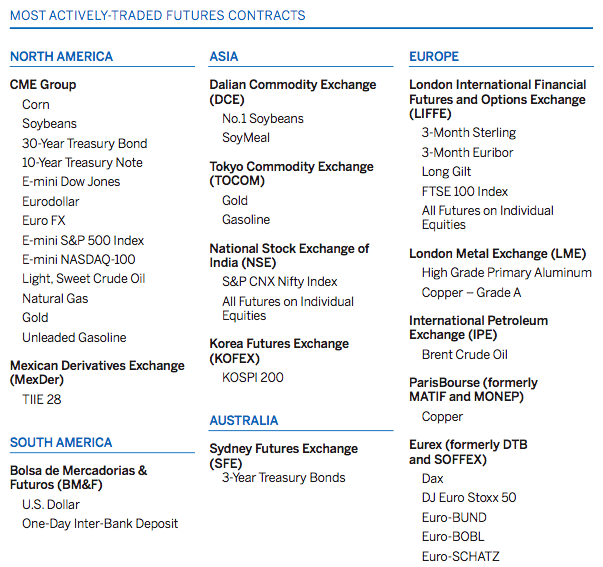
The substantial growth of futures exchanges across the globe afford trading advisors countless opportunities to diversify their portfolios by geographic markets, as well as by product. Trading advisors thus have ample opportunity for profit potential and risk reduction among a broad array of non-correlated markets. Investing in managed futures on a global scale provides protection against geospecific variables such as poor weather or political unrest, which could affect some commodities or financial futures more than others.
4. OPPORTUNITY TO PROFIT IN A VARIETY OF ECONOMIC ENVIRONMENTS
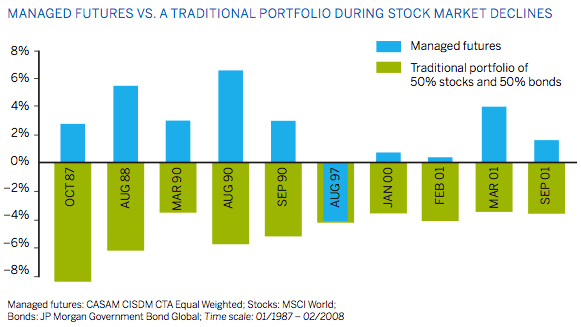
Managed futures trading advisors can generate profit in both increasing or decreasing markets due to the their ability to go long (buy) futures positions in anticipation of rising markets or go short (sell) futures positions in anticipation of falling markets. Moreover, trading advisors are able to go long or short with equal ease. This ability, coupled with their virtual non-correlation with most traditional asset classes, have resulted in managed futures funds performing well relative to traditional asset classes during adverse conditions for stocks and bonds.

For example, during periods of hyperinflation, hard commodities such as gold, silver, oil, grains and livestock tend to do well, as do the major world currencies. Conversely, during deflationary times, futures provide an opportunity to profit by selling into a declining market with the expectation of buying, or closing out the position, at a lower price. Trading advisors can even use strategies employing options on futures contracts that allow for profit potential in flat or neutral markets.
This ability to accommodate and protect against unpredictable events can be invaluable in today's volatile global markets.
5. LIMITED LOSSES DUE TO A COMBINATION OF FLEXIBILITY AND DISCIPLINE
POTENTIAL TO LIMIT DRAWDOWNS
Drawdowns, or the reduction a fund might experience during a market retrenchment, are an inevitable part of any investment. However, because managed futures trading advisors can go long or short and typically adhere to strict stop-loss limits managed futures funds have limited their drawdowns more effectively than many other investments. As the following chart shows, drawdowns for managed futures have been less steep than those for major global equity indices.
ABILITY TO RECOVER QUICKLY
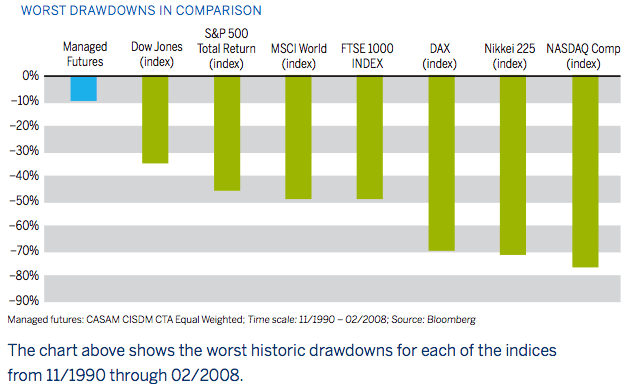 Additionally, managed futures generally have shorter recovery times from drawdown periods. This is due in part to the ability to use short trading to take advantage of falling markets, as well as the fact that managed futures often have lower losses to recover.
Additionally, managed futures generally have shorter recovery times from drawdown periods. This is due in part to the ability to use short trading to take advantage of falling markets, as well as the fact that managed futures often have lower losses to recover.

Unable to use short trading to take advantage of falling markets, traditional stock indices may experience extreme drawdowns in bear markets. With reference to the previous chart, the maximum drawdown for stocks was -44.7 percent during the period of 09/2000 through 09/2002. It takes much longer to make up for such large drawdowns. To simply recover, the stock index needed to regain almost 80 percent of its new low level.
THE EFFICIENCIES AND PERFORMANCE OF FUTURES MARKETS
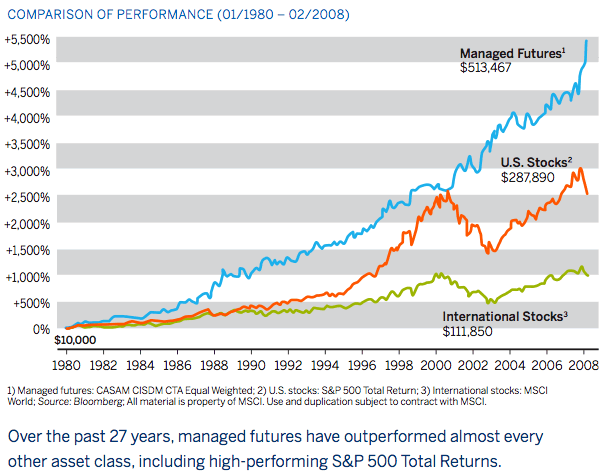 While managed futures are new to some, banks, corporations and mutual fund managers have used futures markets to manage their exposure to price change for decades. Futures markets make it possible for these companies "to hedge" or transfer their risk to other market participants, including speculators, who assume this risk in anticipation of making a profit.
While managed futures are new to some, banks, corporations and mutual fund managers have used futures markets to manage their exposure to price change for decades. Futures markets make it possible for these companies "to hedge" or transfer their risk to other market participants, including speculators, who assume this risk in anticipation of making a profit.
Without speculators, price discovery would only occur when both a producer and an end user want to execute a transaction at the same time. When speculators enter the marketplace, the number of ready buyers and sellers increases and hedgers are able to execute larger orders at their convenience without effecting a dramatic change in price - providing additional liquidity, which helps ensure market integrity. By selling futures when prices are rising and purchasing as prices fall, their activity can have a stabilizing effect in volatile markets.
Looking back over the past few decades, managed futures have consistently outperformed other asset classes such as stocks and bonds. Consider an initial investment of $10,000 invested in 1980. If placed in a U.S. stock fund mirroring the S&P 500, the investment would have been worth approximately $288,000 as of early 2008. Allocating the same amount to a basket of international equities reflecting the Morgan Stanley Capital International Index of world stocks, the initial investment would have grown to nearly $120,000. But the same investment in managed futures, based on the Center for
International Securities and Derivatives Markets weighting, would now be worth more than $513,000.
MANAGED FUTURES TRADING STRATEGIES
Fund managers' investment strategies tend to fall into one of two primary categories: the major group is known as trend followers, while the other is comprised of market-neutral traders.
Many trend followers use proprietary technical or fundamental trading systems which provide signals of when to go long or short in anticipation of upward or downward market moves (trends). While some trend followers
employ discretionary systems based on fundamental data and the discretion of the fund manager, the majority use fully automated technical trading systems based on a highly objective, disciplined set of rules predefined by the fund management. By removing human emotion, such as fear and greed, from trading decisions, fully automated trading systems rely on predetermined stop-loss orders to limit losses and let profits run.
Market-neutral traders tend to seek profit from spreading between different financial and commodity markets (or different futures contracts in the same market). Also in the market-neutral category are option-premium sellers who use delta- neutral programs. Both spreaders and premium sellers aim to profit from non- directional trading strategies.
TYPES OF INVESTMENT OPPORTUNITIES
A) Retail or public pools
The recent introduction of low minimum- investment levels for retail funds or public pools provides a way for small investors to participate in an investment vehicle formerly exclusive to large investors. In the United States, fund managers' business conduct and trading activities are supervised by the Commodity Futures Trading Commission (CFTC) and the National Futures Association (NFA). In addition, offerings of managed futures funds to the general public are regulated by the CFTC, NFA, the Securities and Exchange Commission (SEC), the Financial Industry Regulatory Authority (FINRA) and individual state regulatory agencies. Public managed futures funds must be audited by independent account firms and follow strict disclosure requirements.
B) Individual accounts
Individual accounts are customized accounts for institutional investors or high net-worth individuals. These funds usually require a substantial capital investment so the advisors can diversify trading among a variety of market positions according to the investors' specifications. For example, certain markets may be emphasized or excluded. Contract terms may include specific termination language and financial management requirements.
C) Private pools
Private pools combine money from several investors and usually take the form of a limited partnership. Most of these pools have minimum investments that can be as high as $250,000. These accounts usually allow for admission and redemption on a monthly or quarterly basis. The main advantage of private pools is the economy of scale that can be achieved for mid-sized investors.
Each of these alternatives may be structured with multiple trading advisors with different trading approaches, providing the investor with maximum diversification.
PARTICIPANTS IN THE MANAGED FUTURES INDUSTRY
There are several types of industry participants qualified to assist interested investors. Keep in mind that any of these participants may, and often do, act in more than one capacity.
Commodity Trading Advisors (CTAs) are responsible for the actual trading of managed accounts. There are approximately 1,750 CTAs registered with the NFA, which is the self-regulatory organization for futures and options markets. The two major types of advisors are technical traders and fundamental traders. Technical traders may use computer software programs to follow pricing trends and perform quantitative analyses. Fundamental traders forecast prices by analysis of supply and demand factors and other market information. Either trading style can be successful and many advisors incorporate elements of both approaches.
Futures Commission Merchants (FCMs) are the brokerage firms that execute, clear and carry CTA-directed trades on the various exchanges. Many of these firms also act as commodity pool operators and trading managers, providing administrative reports on investment performance. Additionally, they may offer customers managed futures funds to help diversify their portfolios.
Commodity Pool Operators (CPOs) assemble public funds or private pools. In the United States, these are usually in the form of limited partnerships. There are approximately 1,250 CPOs registered with the NFA. Most CPOs hire independent CTAs to make trading decisions. CPOs may distribute their funds directly or act as wholesalers to the broker-dealer community.
Investment Consultants can be a valuable resource for institutional investors interested in learning about managed futures alternatives and in helping implement a managed fund program. They can assist in selecting the type of fund program and management team that would be best suited for the specific needs of the institution. Some consultants also monitor day-to-day trading operations (e.g., margins and daily mark-to-market positions) on behalf of their institutional clients.
Trading Managers are available to assist institutional investors in selecting CTAs. These managers have developed sophisticated methods of analyzing CTA performance records so they can recommend and structure a portfolio of trading advisors whose historic performance records have a low correlation with each other. These trading managers may develop and market their own proprietary products or they may administer funds raised by other entities, such as brokerage firms.
EVALUATING RISK FROM AN INVESTOR'S PERSPECTIVE
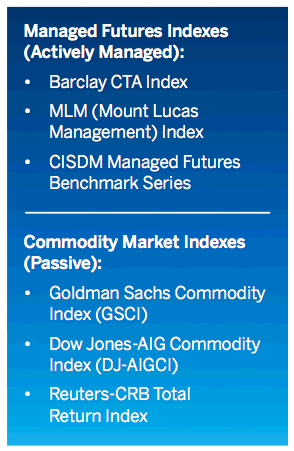 As with any investment, there are risks associated with trading futures and options on futures. The CFTC requires that prospective customers be provided with risk-disclosure statements, which should be carefully reviewed. Past performance is not necessarily an indicator of future results.
As with any investment, there are risks associated with trading futures and options on futures. The CFTC requires that prospective customers be provided with risk-disclosure statements, which should be carefully reviewed. Past performance is not necessarily an indicator of future results.
When choosing a managed futures fund, it is important to ensure the fund manager has a proven track record. Before investing, it is also advisable to check the magnitude and duration of the fund's worst drawdown, or cumulative loss in value from any peak in performance to the subsequent low. In addition, there are several indices that measure managed futures performance. Investors may wish to consult each index to determine which provides the most appropriate performance criteria for their needs. At right is a list of some of the more familiar indexes.
HOW FEES ARE STRUCTURED FOR MANAGED FUTURES
Total management fees in the managed futures industry tend to be higher than those in the equity markets. While management fees do vary according to the type of managed futures account and may be negotiable, a general fee structure exists. Investors should fully understand that performance information for a managed futures account or fund is almost always expressed net of all such fees.
Typically, the trading advisor or trading manager is compensated by receiving a flat management fee based on assets under management, in addition to a performance "incentive" fee based on profits in the account. The performance fee is almost always calculated net of all costs to the account, such as management fees and commissions. The performance fee is thus based on net trading profits, which are usually paid only if the account or fund exceeds previously established net asset values.
A few trading managers assume the "netting risk," whereby the performance results of all trading advisors in the account are netted before the investor is charged a performance fee. The trading manager assumes the netting risk by paying each CTA according to his or her individual performance.
In addition to management and performance fees, an account or fund pays transaction costs or brokerage commissions. These expenses reflect the cost of executing and clearing futures trades and generally are calculated on a per-round-turn basis.
INVESTOR SAFETY IS PARAMOUNT IN THE FUTURES MARKET
Protecting the interests of all participants in the futures market is the responsibility of exchange and industry members as well as federal regulators. Working together, they ensure the financial and market integrity required by investors. A brief overview of CME Clearing will illustrate why the credit risk of exchange-traded products is minimal for futures investors.
The market integrity of CME Group...
CME Group rules and regulations are designed to support competitive, efficient and liquid markets. These rules and regulations are reviewed continuously and are periodically amended to reflect the needs of market users. Making sure that trading practices and regulations are followed is the responsibility of the exchange's Market Regulation and Audit Departments, which work to prevent trading irregularities and investigate possible violations of exchange and industry regulations. The departments provide daily on-site surveillance of trading activity, continuous monitoring of member firms' trading practices with state-of-the-art technology and prompt, thorough investigations of any customer complaints.
...Combined with the financial integrity of CME Clearing
Clearing operations are another mechanism used by exchanges to uphold the integrity of the futures markets. CME Clearing 1) acts as a guarantor to clearing member firms for trades it maintains; 2) reconciles all clearing member firm accounts each day to ensure that all gains have been credited and all losses have been collected; and, 3) sets and adjusts clearing member firm margins for changing market conditions.
CME Clearing settles the account of each member firm at the end of the trading day, balancing quantities of contracts bought with those sold. In clearing trades, the clearinghouse substitutes itself as the opposite party in each transaction, essentially eliminating counterparty credit risk. It interposes itself as the buyer to every seller and the seller to every buyer and becomes, in effect, a party to every clearing member transaction. Because of this substitution, it is no longer necessary for a buyer (or seller) to find the original seller (or buyer) when offsetting a position. A market participant merely executes an equal and opposite transaction, usually with an entirely different party, and ends up with a net zero position.
One of the most important financial safeguards in ensuring performance on futures contracts is the performance bond, which is a deposit clearing member firms must post and maintain against their open positions. These performance bonds, also referred to as margins, are set by CME Clearing based on each product. Your broker may require a larger deposit for your account.
CME Clearing settles its accounts daily. As closing or settlement prices change the value of outstanding futures positions, the clearinghouse collects from those who have lost money as a result of price changes and credits those funds immediately to the accounts of those who have gained. Thus, before each trading day begins, all of the previous day's losses have been collected and all gains have been paid or credited. In this way, CME Clearing maintains very tight control over performance bonds as prices fluctuate, ensuring that sufficient money is on deposit at all times.
For more information:
About the futures market
CME Group is dedicated to helping investors learn more about the benefits of using the futures market. It offers a wide variety of educational publications and research materials that can be reviewed and ordered online at www.cmegroup.com.
About managed futures
Contact the sources listed here for information about other topics related to managed futures:
REGULATORY AGENCIES
Commodity Futures Trading Commission
Three Lafayette Centre 1155 21st Street, NW Washington, D.C. 20581 202 418 5000 Fax: 202 418 5521 www.cftc.gov
National Futures Association (NFA)
300 South Riverside, Suite 1800 Chicago, IL 60606-6615 312 781 1300 Fax: 312 781 1467 www.nfa.futures.org
INDUSTRY ASSOCIATIONS
Futures Industry Association (FIA)
2001 Pennsylvania Avenue NW Suite 600 Washington, D.C. 20006 1807 202 466 5460 Fax: 202 296 3184 www.futuresindustry.org
Managed Funds Association (MFA)
2025 M Street NW, Suite 610 Washington, D.C. 20036 3309 202 367 1140 Fax: 202 367 2140 www.managedfunds.org
RESEARCH AND REPORTING SERVICES
Barclay Hedge Ltd.
2094 185th Street, Suite 1B Fairfield, IA 52556 641 472 3456 Fax: 641 472 9514 www.barclayhedge.com
Center for International Securities and Derivatives Markets (CISDM)
Isenberg School of Management University of Massachusetts 121 Presidents Drive Amherst, MA 01003 413 577 3166 Fax: 413 577 1350 www.cisdm.org
For information on the performance of public managed futures funds, go to Futures Magazine's "Public Funds Summary" at www.futuresmag.com/futurespublicfunds.
Futures trading is not suitable for all investors, and involves the risk of loss. Futures are a leveraged investment, and because only a percentage of a contract s value is required to trade, it is possible to lose
should be devoted to any one trade because they cannot expect to profit on every trade. All references to options refer to options on futures. CME Group is the trademark of CME Group, Inc. The Globe logo, Globex and CME are trademarks of Chicago Mercantile Exchange, Inc. CBOT is the trademark of the Board of Trade of the
City of Chicago. NYMEX, New York Mercantile Exchange, and ClearPort are trademarks of New York Mercantile Exchange. Inc. COMEX is a trademark of Commodity Exchange, Inc. All other trademarks are the property of their respective owners. "S&P 500", "S&P Asia 50", "S&P MidCap 400" and "S&P SmallCap 600" are trademarks of The McGraw Hill Companies, Inc., used under license. "MSCI" and "EAFE" are trademarks of MSCI, used under license.
"NASDAQ 100" is a registered trademark of the Nasdaq Stock Market, Inc. and is licensed for use by the Chicago Mercantile Exchange Inc. Dow Jones , AIG, Dow Jones AIG Commodity Index and DJ AIGCI are registered trade marks or service marks of Dow Jones & Company, Inc. and American International Group, Inc. (AIG).
MLM Index is a trademark of Mount Lucas Management Corporation.
This information has been compiled by CME Group for general purposes only. CME Group assumes no responsibility for any errors or omission. Additionally, all examples in this brochure are hypothetical situations, used for explanation purposes only, and should not be considered investment advice or the results of actual market experience.
Copyright (C) 2008 CME Group. All rights reserved.
CME Group Heardquarter CME Group Global oFFiCEs 20 South Wacker Drive Chicago, Illinois 60606 cmegroup.com info@cmegroup.com 800 331 3332 312 930 1000 Chicago Washington D.C. singapore New York hong Kong sydney houston london tokyo
